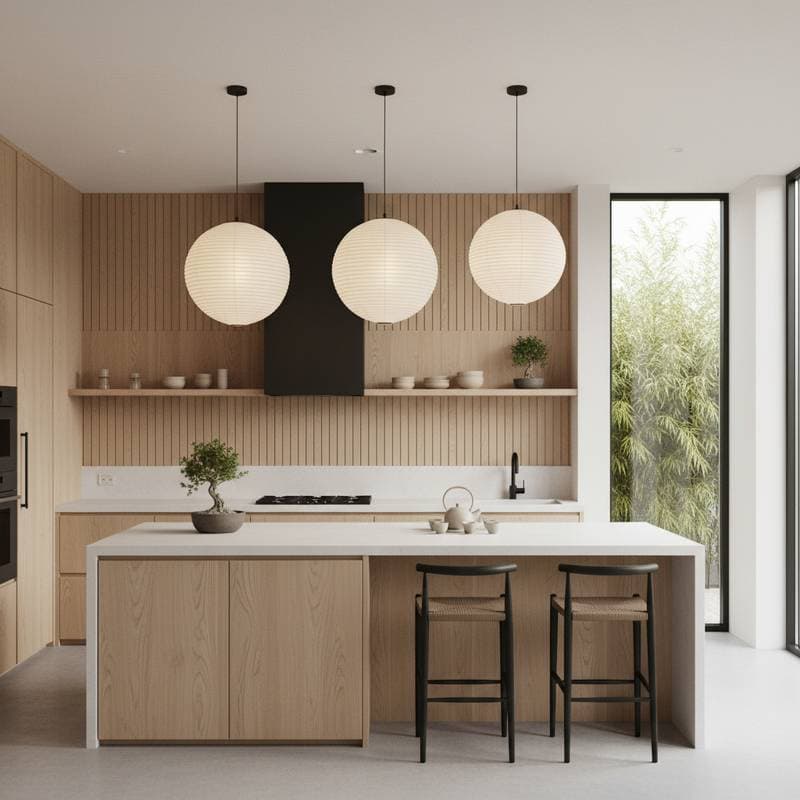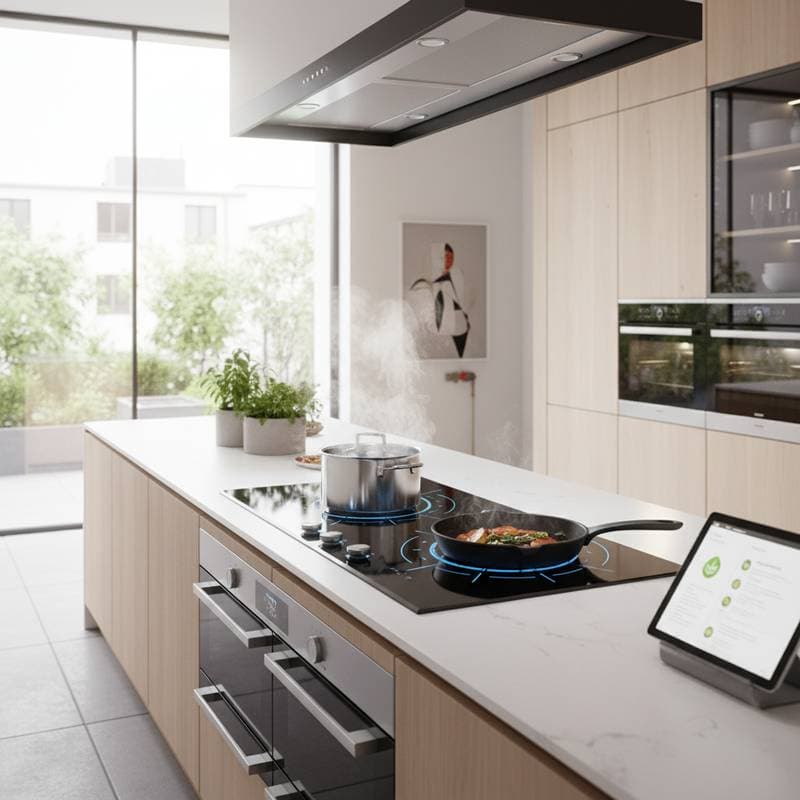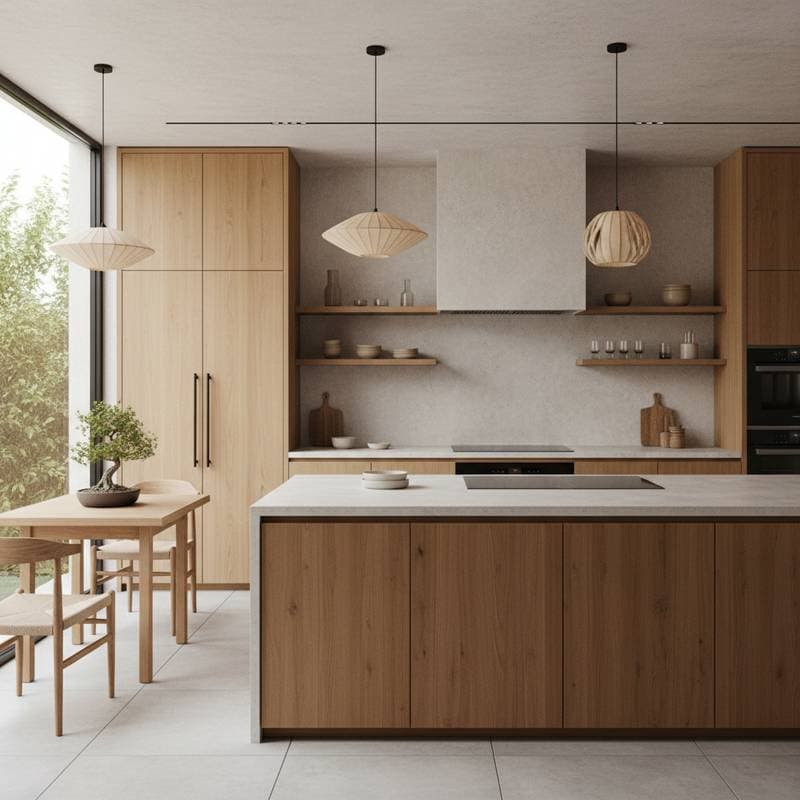Why Homeowners Choose Japandi Kitchens Over All-White
All-white kitchens defined modern design for years with their bright, clean lines and sense of openness. However, many homeowners now seek designs that provide emotional depth alongside functionality. Japandi kitchens emerge as a compelling alternative, merging Japanese minimalism with Scandinavian warmth to create serene yet inviting environments.
This style prioritizes natural materials, subtle earth tones, and thoughtful simplicity. The transition from stark white to Japandi reflects a broader yearning for authenticity and comfort in living spaces. The following ten reasons illustrate how Japandi redefines kitchen design for contemporary lifestyles.
1. Serenity Through Intentional Simplicity
Japandi design strips away excess to focus on essential elements, fostering a sense of calm that all-white kitchens often lack. Clean lines and open layouts encourage mental clarity, much like a meditative retreat. Homeowners report reduced stress in these spaces, where every item serves a purpose without overwhelming the senses.
To achieve this, select streamlined appliances and avoid ornate hardware. The result is a kitchen that supports focused cooking and relaxed gatherings, enhancing overall well-being.
2. The Rise of Warm Minimalism
Traditional minimalism relied on white surfaces for a stark, unadorned look. Japandi introduces warm minimalism by incorporating subtle textures and neutral palettes that soften the aesthetic. Cabinetry crafted from European oak, raked ash, or walnut veneer supplants glossy white finishes, adding organic depth.
Walls painted in shades such as Skimming Stone by Farrow & Ball or Revere Pewter by Benjamin Moore introduce gentle gray-beige hues that evolve with natural light. Matte surfaces and wood grains create subtle visual interest, ensuring the space remains uncluttered yet welcoming. This approach delivers restraint without chill, inviting daily use.
3. Earthy Tones That Nourish the Spirit
All-white kitchens can feel clinical under harsh lighting, but Japandi employs earthy tones to evoke grounding comfort. Soft beiges, muted greens, and warm grays draw from nature, promoting a soothing atmosphere. These colors harmonize with wooden elements, creating a cohesive palette that feels timeless.
Consider accents like terracotta tiles for backsplashes or sage-hued textiles for seating. Such choices absorb light gently, reducing glare and enhancing coziness during evening hours. The palette supports emotional balance, turning the kitchen into a restorative hub.
4. Wood as the Heartbeat of the Kitchen
Wood forms the core of Japandi aesthetics, infusing spaces with natural warmth and character. Pale Douglas fir and Scandi pine provide light frameworks, while smoked oak or burnt cedar, influenced by the Japanese shou sugi ban technique, offer darker contrasts for balance.
Designers vary grain patterns and finishes for visual rhythm; vertical grains in cabinetry elongate narrow areas, and flat-sawn panels highlight organic flows. A matte oil finish preserves the wood's inherent beauty without shine, aligning with the style's understated ethos. This material choice ensures durability and a tactile connection to craftsmanship.
5. Natural Materials for Sustainability
Japandi prioritizes eco-friendly materials, contrasting the synthetic feel of all-white laminates. Bamboo countertops, reclaimed wood islands, and linen aprons contribute to lower environmental impact while adding authentic texture. These selections age gracefully, reducing the need for frequent replacements.
Sourcing from sustainable forests or recycled sources aligns with mindful living principles. The inherent variations in natural materials prevent uniformity, making each kitchen uniquely personal. This focus on sustainability appeals to environmentally conscious homeowners seeking long-term value.
6. Functional Beauty and Hidden Storage
Efficiency defines both Japanese and Scandinavian influences in Japandi kitchens. Integrated storage solutions, concealed appliances, and sleek cabinetry maximize utility without visual chaos. Each element, from pull-out pantries to recessed outlets, enhances workflow.
Finger pulls or handleless designs maintain smooth lines, while floating oak or bamboo shelves replace bulky uppers, allowing curated displays of essentials. This organization promotes ease in meal preparation and cleanup, blending poetry with practicality. The space adapts seamlessly to diverse daily needs.
7. Lighting That Enhances Mood
Strategic lighting in Japandi kitchens creates layered ambiance, far beyond the flat brightness of all-white setups. Pendant fixtures in rice paper or frosted glass diffuse soft glows, while under-cabinet LEDs highlight textures without stark shadows.
Natural light flows through large windows or skylights, complemented by dimmable options for versatility. Warm bulbs in the 2700K range mimic sunlight, fostering relaxation during mornings or evenings. This thoughtful illumination elevates the kitchen's role as a versatile living area.
8. The Influence of Craftsmanship
Every detail in a Japandi kitchen honors skilled artistry, embracing the wabi-sabi philosophy that values imperfection and transience. Handcrafted ceramics, bespoke joinery, and artisanal fixtures underscore human involvement over factory uniformity.
Designer Mara Lindholm of Atelier Nordøya notes that clients connect deeply with visible craftsmanship. She states, "When people can see the joinery, the brushstroke, or the kiln mark, they feel connected to their space." This emphasis shifts focus from perfection to meaningful narrative, enriching the home's story.
9. Integration with Surrounding Nature
Japandi kitchens blur boundaries between indoors and outdoors, incorporating views or biophilic elements absent in enclosed all-white designs. Large glass doors or indoor plants extend the space toward gardens, promoting harmony with the environment.
Materials like stone sinks or moss-inspired accents reinforce this connection. Such integration reduces feelings of isolation, encouraging outdoor-inspired rituals like herb harvesting. The design cultivates a sense of continuity, making the kitchen an extension of natural rhythms.
10. A Kitchen for Living, Not Just Cooking
Japandi kitchens serve multifaceted roles, supporting rituals from solitary brewing to communal dining. Integrated seating at islands or window benches invites pause and interaction, unlike the utilitarian vibe of all-white spaces.
The layout embodies ma, the Japanese appreciation for negative space as potential rather than void. Materials patina over time, recording life's moments. This adaptability nurtures slow living, where the kitchen becomes a sanctuary for reflection and connection.
Adding Personal Touches
With core elements established, subtle additions infuse individuality. A linen runner across the table, a hand-thrown vase, or a suspended paper lantern introduces softness without excess. These items echo the palette while sparking joy.
Greenery, such as eucalyptus branches or trailing pothos, brings vitality and subtle motion. Display cookware like cast iron skillets or wooden utensils with care, turning functional objects into decorative assets. These choices personalize the space thoughtfully.
Embracing Japandi for Enduring Comfort
All-white kitchens offered pristine appeal, yet often demanded constant upkeep. Japandi provides a sustainable path forward, celebrating quiet beauty and intentional details. It fosters environments where warmth arises from material authenticity and design restraint.
Homeowners experience heightened awareness in these kitchens, savoring simple pleasures amid balanced simplicity. The style proves that true elegance lies in harmony between form, function, and feeling, transforming the heart of the home into a source of lasting fulfillment.










